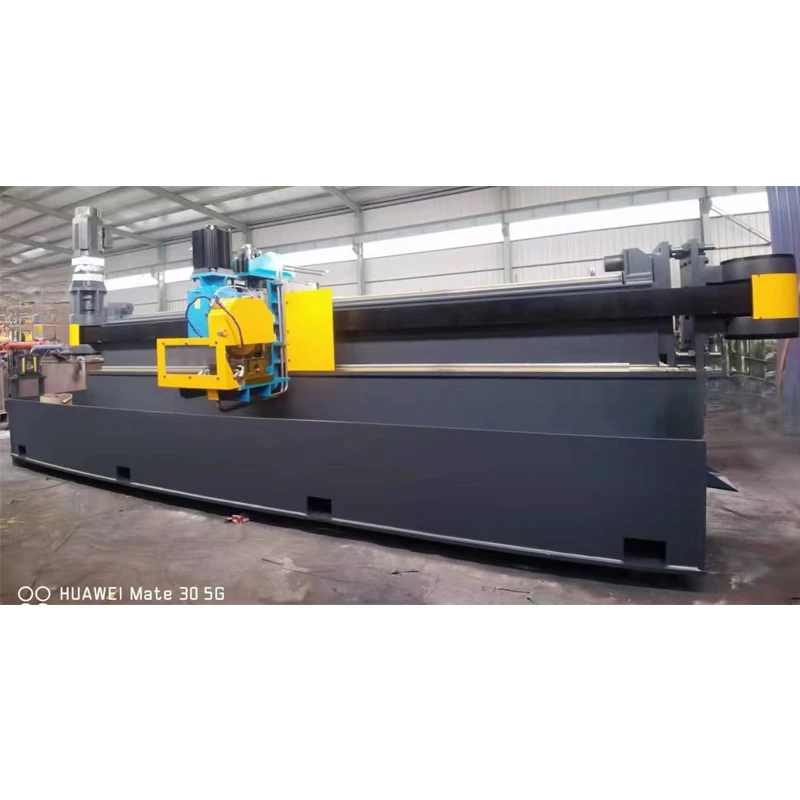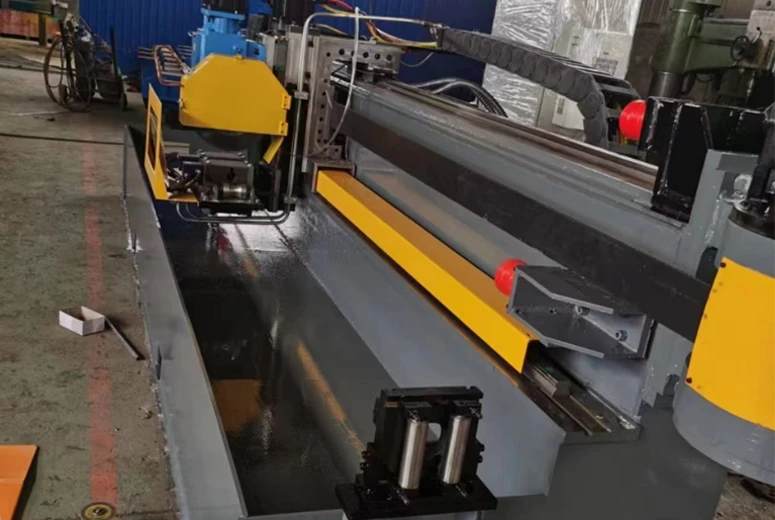High-Speed Flying Cut Off Saws for Precise Cold Cutting
- Technological advantages of modern cutting systems
- Operational principles and structural components
- Comparative analysis of leading manufacturers
- Custom engineering solutions for specialized needs
- Real-world industrial application scenarios
- Maintenance protocols and operational safety
- Future development trajectory of precision cutting

(flying cut off saw)
Revolutionizing Production with Flying Cut Off Saw Technology
Industrial cutting has undergone radical transformation since the introduction of flying cut off saw
systems. These high-precision machines perform simultaneous cutting and tracking operations while materials move continuously through production lines. Unlike traditional stationary saws, flying cut off saw technology enables manufacturers to achieve blistering operational speeds up to 120 meters/minute while maintaining tolerances within ±0.2mm. The key distinction lies in the synchronized movement: as the material advances along the conveyor, the entire cutting apparatus travels alongside it at matching velocity during the cutting cycle.
The operational efficiency gains are quantifiable and significant. Manufacturers report 40-60% reduction in material waste compared to static cutting methods. For tubing applications alone, this translates to approximately $18,000 annual savings per production line on stainless steel wastage. Modern cold cut flying saw variants eliminate heat-affected zones entirely, preserving material integrity and reducing secondary processing needs. This proves particularly valuable in aerospace applications where compromised metallurgy poses serious safety concerns.
Operational Mechanics and System Architecture
Flying cut off machines integrate multiple sophisticated subsystems into a cohesive cutting solution. The primary structural framework features hardened steel guide rails spanning 6-12 meters, supporting a mobile carriage weighing up to 3.5 tons. Hydraulic dampeners and linear bearings facilitate near-frictionless movement while electromagnetic brakes deliver instantaneous stoppage accuracy. Power transmission originates from dual-phase servo motors generating up to 45kW of cutting force, synchronized with line speed through programmable logic controllers.
The cutting head assembly contains the true technological marvel - carbide-tipped cold cutting blades rotating at 800-1200 RPM while traversing parallel to material flow. Dust extraction ports surrounding the cutting zone capture 98.7% of particulate matter, complying with strict air quality regulations. Vibration dampening technology maintains positional integrity, enabling clean cuts on delicate extrusions as thin as 0.8mm wall thickness. Through advanced harmonic reduction engineering, modern systems operate below 85 decibels despite enormous cutting forces.
Manufacturer Capabilities Comparison
| Manufacturer | Max Speed | Cut Tolerance | Material Thickness | Specialization | Service Network |
|---|---|---|---|---|---|
| Kasto Win | 90 m/min | ±0.15mm | 180mm | Structural steel | 62 countries |
| Behringer | 110 m/min | ±0.20mm | 250mm | Heavy plate | Global |
| Kaltenbach | 75 m/min | ±0.08mm | 120mm | Precision tubing | 38 countries |
| EMG Eurosystems | 125 m/min | ±0.25mm | 200mm | High-speed lines | European focus |
Leading manufacturers differentiate through specialized engineering approaches. Kasto's Harmonic Damper technology claims vibration reduction 47% beyond industry standards, particularly beneficial for architectural aluminum extrusion. Behringer's Gravity Compensation System maintains cut precision during acceleration/deceleration phases where competitors typically exhibit ±0.3mm deviation. For high-volume production requiring extreme precision, Kaltenbach's dual-laser measurement achieves continuous dimensional verification during cutting operations.
Tailored Engineering Solutions
Custom flying cut off machine configurations overcome unique production challenges. A Scandinavian window manufacturer recently implemented a mirrored dual-saw configuration capable of simultaneously cutting four vinyl profiles at 85 m/min. This custom arrangement incorporated 15-degree angular cutting heads to create ready-to-weld miter joints, eliminating three secondary operations. The $2.7 million investment yielded 18-month ROI through labor reduction and increased line speed.
Material-specific modifications include hardened blade coatings for fiber-reinforced composites and active coolant systems for titanium alloys. One aerospace contractor solved chronic chip welding issues by implementing pulsed-spray technology delivering 0.6 gallons/minute of specialized cutting fluid at precisely controlled intervals. Production stoppages decreased from weekly occurrences to just twice annually, saving $370,000 in annual downtime costs. Recent innovations focus on rapid-change tooling allowing complete saw head reconfiguration in under 23 minutes for mixed-material production environments.
Industry Application Scenarios
Automotive manufacturing provides compelling implementation metrics. On transmission component lines, flying cut off machines process case-hardened steel shafts at 74 cuts/minute. The continuous operation maintains consistent cycle times impossible with conventional saws, contributing to Toyota's renowned production system efficiency. Quality metrics confirm less than 0.03% cut surface imperfections when monitored under 400x magnification.
Construction materials represent another significant application. PVC pipe manufacturers using cold cut flying saw technology report 92% reduction in end deformation compared to friction cutting. This eliminates expensive reaming operations required for proper fitting assembly. One producer supplying underground conduit achieved 7.2 kilometers of continuous cutting per eight-hour shift using specialized wear-resistant blades lasting 17% longer than standard carbide tools. In aluminum solar frame production, integrated nesting software maximizes material utilization to 96.7% while maintaining cutting throughput of 72 frames/minute.
Maintenance Best Practices
Proactive maintenance protocols extend machine lifespan beyond typical industrial equipment. Daily operational checks should verify lubrication levels in four critical reservoir systems and inspect hydraulic pressures within the 16-21 MPa operational range. Blade tension requires weekly verification using ultrasonic measurement devices capable of detecting as little as 2% tension loss before cut quality degrades.
Scheduled maintenance follows rigorous intervals: guide rail realignment every 1,500 operating hours, servo motor brush replacement at 5,000 hours, and complete hydraulic system overhaul biennially. These measures prevent escalating issues like harmonic resonance in drivetrain components. Safety systems demand particular attention with light-curtain functionality tests performed weekly and emergency-stop response time verified monthly. Advanced facilities utilize vibration spectroscopy analysis to predict bearing failures up to 400 hours before actual breakdown occurs.
Flying Cut Off Systems Driving Industry 4.0
The trajectory for flying cut off saw technology points toward deeper integration with digital manufacturing environments. Current machines export 127 distinct operational parameters to plant management systems, providing unprecedented production visibility. Predictive analytics now forecast blade degradation 15 minutes before cut quality declines using algorithmic analysis of power consumption patterns and vibration signatures.
Emerging adaptive control systems demonstrate potential for eliminating trial cuts when processing unfamiliar alloys. By analyzing metallurgical composition in real-time and cross-referencing cutting parameters from material databases, these systems automatically optimize blade speed and feed pressure. Ongoing research explores artificial intelligence implementation for fault diagnosis, with early trials reducing technical downtime by 28% through instantaneous component failure identification. These innovations solidify the flying cut off machine as an indispensable production technology evolving to meet tomorrow's manufacturing challenges.

(flying cut off saw)
FAQS on flying cut off saw
Q: What is a flying cut off saw?
A: A flying cut off saw is a specialized industrial saw that moves synchronously with materials (like pipes or profiles) during cutting. It enables precise, burr-free cuts on moving production lines without stopping the feed. This technology is essential for continuous manufacturing processes.
Q: How does a flying cut off machine work?
A: The flying cut off machine accelerates to match the material's speed, clamps the workpiece, and executes the cut while maintaining synchronization. After cutting, it rapidly returns to its start position for the next cycle. This "fly-back" mechanism ensures non-stop processing of extruded or rolled materials.
Q: What are the benefits of a cold cut flying saw?
A: Cold cut flying saws prevent material deformation by eliminating heat-induced stress during cutting. They deliver clean, precision cuts without sparks or discoloration. This makes them ideal for sensitive materials like aluminum or coated steel.
Q: What industries use flying cut off saws?
A: Flying cut off saws are critical in pipe/tube mills and metal extrusion plants. They're also extensively used in automotive part manufacturing and construction material production. Any industry requiring high-speed, precision cutting of moving materials utilizes this equipment.
Q: What factors determine flying cut off machine performance?
A: Key performance factors include synchronization accuracy, blade quality, and servo-motor responsiveness. Cutting capacity (material thickness/hardness) and cycle speed also dictate efficiency. Advanced models feature CNC controls for precision angle cutting and automation integration.
-
Welded Pipe Production Line - BzZhou Xinghua Machinery Equipment Manufacturing Co., LTD.|High-Frequency Straight Seam Welding&Precision EngineeringNewsJul.22,2025
-
Welded Pipe Production Line - BzZhou Xinghua Machinery|High-Efficiency, Precision EngineeringNewsJul.21,2025
-
Welded Pipe Production Line-BzZhou Xinghua Machinery Equipment Manufacturing Co.,LTD.|High Precision, Efficient ProductionNewsJul.21,2025
-
Welded Pipe Production Line-BzZhou Xinghua Machinery Equipment Manufacturing Co.,LTD.|High Precision, Efficient ProductionNewsJul.21,2025
-
Welded Pipe Production Line-BzZhou Xinghua Machinery Equipment Manufacturing Co.,LTD.|High Precision, Efficient ProductionNewsJul.21,2025
-
Welded Pipe Production Line-BzZhou Xinghua|High Efficiency&CustomizationNewsJul.21,2025


